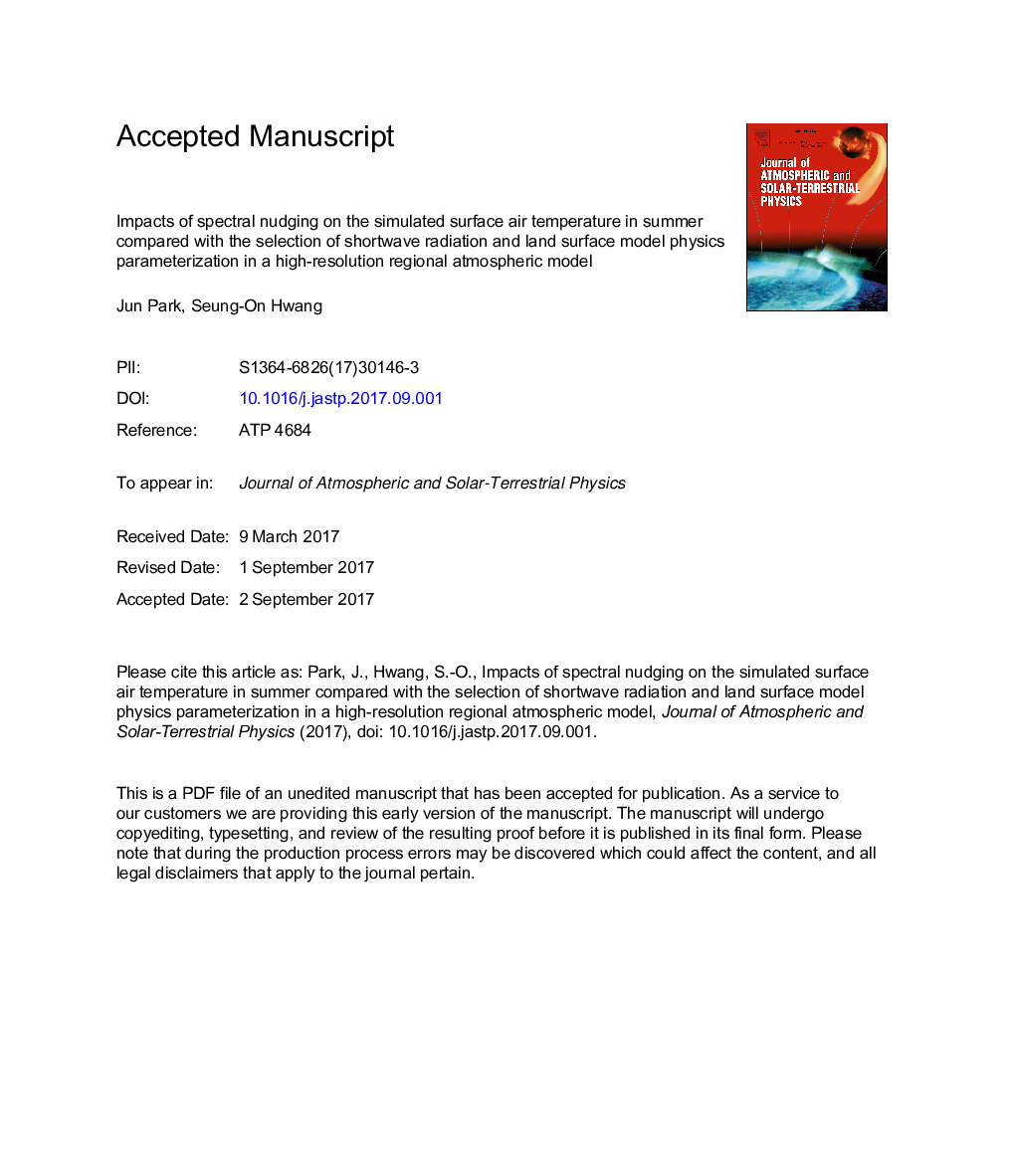| کد مقاله | کد نشریه | سال انتشار | مقاله انگلیسی | نسخه تمام متن |
|---|---|---|---|---|
| 5487479 | 1523586 | 2017 | 37 صفحه PDF | دانلود رایگان |
عنوان انگلیسی مقاله ISI
Impacts of spectral nudging on the simulated surface air temperature in summer compared with the selection of shortwave radiation and land surface model physics parameterization in a high-resolution regional atmospheric model
ترجمه فارسی عنوان
تاثیر تابش طیفی بر روی دمای هوا شبیه سازی شده در تابستان در مقایسه با انتخاب پارامترهای فیزیکی مدل تابش مادون قرمز و سطح زمین در یک مدل اتمسفر منطقه ای با وضوح بالا
دانلود مقاله + سفارش ترجمه
دانلود مقاله ISI انگلیسی
رایگان برای ایرانیان
کلمات کلیدی
مدل منطقه ای با وضوح بالا، مقیاس دینامیکی، فشار دادن طیفی، تابش خورشید، مدل سطح زمین،
ترجمه چکیده
تأثیر تکنیک برانگیختگی طیفی برای کاهش پویایی دمای هوای تابستانی در یک مدل اتمسفر منطقه ای با وضوح بالا ارزیابی می شود. عملکرد این تکنیک با مقایسه 16 مجموعه تحلیل شبیه سازی شده از ترکیب پارامترهای فیزیکی دو تابش خورشید و چهار طرح مدل زمین سطح مدل، که برای شبیه سازی دمای هوا سطح بسیار مهم است، شناخته شده است. یافته شده است که استفاده از نوسان طیفی به دامنه ی خارج از محدوده تاثیر بیشتری بر آب و هوای منطقه ای دارد تا هر ترکیبی از طرح های فیزیکی خورشیدی مادون قرمز و سطح زمین. انتخاب مطلوب پارامترهای فیزیک دو مدل برای به دست آوردن توزیع فضایی زمانی بیشتر از متغیرهای سطح زمین مانند دمای هوا، بارش و شیب سطحی مفید است. با این حال، استفاده از نوسان طیفی ارزش بیشتری را برای نتایج به دست می آورد؛ بهبودی بیشتر از استفاده از پارامترهای فیزیکی پیشرفته تابش خورشید و زمین سطح زمین است. این نتیجه نشان می دهد که نوسان طیفی که در دامنه ی خارج از محدوده اعمال می شود، شرایط مرزی جانبی دقیق تر را به دامنه ی درونی تر می دهد که به وسیله ی داده های تجزیه و تحلیل توسط تضمین سازگاری با اعمال مجاز بزرگ در دامنه ی منطقهای، مجبور می شود. این در نتیجه به طور غیر مستقیم دو پارامترهای فیزیکی را برای تولید ویژگی های مقیاس کوچک نزدیک به مقادیر مشاهده شده کمک می کند، که منجر به نمایندگی بهتر از دمای هوا در هوا در محیط زیست کمینه شده با وضوح بالا می شود.
موضوعات مرتبط
مهندسی و علوم پایه
علوم زمین و سیارات
فیزیک زمین (ژئو فیزیک)
چکیده انگلیسی
The impact of a spectral nudging technique for the dynamical downscaling of the summer surface air temperature in a high-resolution regional atmospheric model is assessed. The performance of this technique is measured by comparing 16 analysis-driven simulation sets of physical parameterization combinations of two shortwave radiation and four land surface model schemes of the model, which are known to be crucial for the simulation of the surface air temperature. It is found that the application of spectral nudging to the outermost domain has a greater impact on the regional climate than any combination of shortwave radiation and land surface model physics schemes. The optimal choice of two model physics parameterizations is helpful for obtaining more realistic spatiotemporal distributions of land surface variables such as the surface air temperature, precipitation, and surface fluxes. However, employing spectral nudging adds more value to the results; the improvement is greater than using sophisticated shortwave radiation and land surface model physical parameterizations. This result indicates that spectral nudging applied to the outermost domain provides a more accurate lateral boundary condition to the innermost domain when forced by analysis data by securing the consistency with large-scale forcing over a regional domain. This consequently indirectly helps two physical parameterizations to produce small-scale features closer to the observed values, leading to a better representation of the surface air temperature in a high-resolution downscaled climate.
ناشر
Database: Elsevier - ScienceDirect (ساینس دایرکت)
Journal: Journal of Atmospheric and Solar-Terrestrial Physics - Volume 164, November 2017, Pages 259-267
Journal: Journal of Atmospheric and Solar-Terrestrial Physics - Volume 164, November 2017, Pages 259-267
نویسندگان
Jun Park, Seung-On Hwang,
